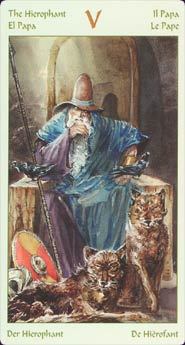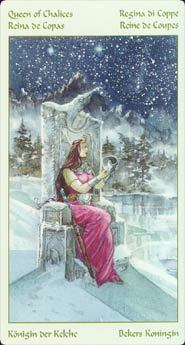T is for Tension
Tension is a vital part of any novel, regardless of genre. An online dictionary defines tension as:
"mental or emotional strain; intense, suppressed suspense, anxiety, or excitement." This anxiety, excitement and suspense is paramount to make your reader keep reading. Like my post on "Q is for Question at Chapter's End," you want to leave something unanswered, something hanging, at the end of most, if not all, chapters. But tension is good within a chapter or scene, also. Example: your hero and heroine have an argument and it looks like they may break up. This isn't the end of the chapter or scene...perhaps the hero's mother arrives, or the heroine's child comes home from school, so continuing the argument must wait until later. But the reader will still feel the suspense and emotional strain of wondering if they will get past this roadblock--if you've done your job right! Today's Tarot deck is the Viking Tarot. Here are a couple of sample cards from the deck:
 Images courtesy of Aeclectic Tarothttp://www.aeclectic.net/tarot/cards/vikings/ I asked what I could do to up the tension in my manuscript. The card I drew was the Knight of Swords. This card indicates courage, but also anger and destruction. I interpret this as meaning one way to up the tension is to have something destroyed. It could be physical destruction and unintended, like the heroine has an accident while driving the hero's car. It could be physical destruction and intentional, such as the villain smashing the windows in the heroine's home. Or it could be emotional destruction, like when the hero thinks he's lost the heroine and he is devastated by his perceived loss. Anything that ups the tension in the story will keep your reader avidly turning page after page!
Images courtesy of Aeclectic Tarothttp://www.aeclectic.net/tarot/cards/vikings/ I asked what I could do to up the tension in my manuscript. The card I drew was the Knight of Swords. This card indicates courage, but also anger and destruction. I interpret this as meaning one way to up the tension is to have something destroyed. It could be physical destruction and unintended, like the heroine has an accident while driving the hero's car. It could be physical destruction and intentional, such as the villain smashing the windows in the heroine's home. Or it could be emotional destruction, like when the hero thinks he's lost the heroine and he is devastated by his perceived loss. Anything that ups the tension in the story will keep your reader avidly turning page after page!
"mental or emotional strain; intense, suppressed suspense, anxiety, or excitement." This anxiety, excitement and suspense is paramount to make your reader keep reading. Like my post on "Q is for Question at Chapter's End," you want to leave something unanswered, something hanging, at the end of most, if not all, chapters. But tension is good within a chapter or scene, also. Example: your hero and heroine have an argument and it looks like they may break up. This isn't the end of the chapter or scene...perhaps the hero's mother arrives, or the heroine's child comes home from school, so continuing the argument must wait until later. But the reader will still feel the suspense and emotional strain of wondering if they will get past this roadblock--if you've done your job right! Today's Tarot deck is the Viking Tarot. Here are a couple of sample cards from the deck:

 Images courtesy of Aeclectic Tarothttp://www.aeclectic.net/tarot/cards/vikings/ I asked what I could do to up the tension in my manuscript. The card I drew was the Knight of Swords. This card indicates courage, but also anger and destruction. I interpret this as meaning one way to up the tension is to have something destroyed. It could be physical destruction and unintended, like the heroine has an accident while driving the hero's car. It could be physical destruction and intentional, such as the villain smashing the windows in the heroine's home. Or it could be emotional destruction, like when the hero thinks he's lost the heroine and he is devastated by his perceived loss. Anything that ups the tension in the story will keep your reader avidly turning page after page!
Images courtesy of Aeclectic Tarothttp://www.aeclectic.net/tarot/cards/vikings/ I asked what I could do to up the tension in my manuscript. The card I drew was the Knight of Swords. This card indicates courage, but also anger and destruction. I interpret this as meaning one way to up the tension is to have something destroyed. It could be physical destruction and unintended, like the heroine has an accident while driving the hero's car. It could be physical destruction and intentional, such as the villain smashing the windows in the heroine's home. Or it could be emotional destruction, like when the hero thinks he's lost the heroine and he is devastated by his perceived loss. Anything that ups the tension in the story will keep your reader avidly turning page after page!
Published on April 23, 2016 08:58
No comments have been added yet.



